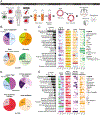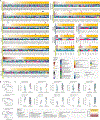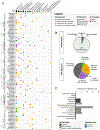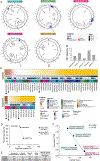The landscape of drug sensitivity and resistance in sarcoma
- PMID: 39305899
- PMCID: PMC12318355
- DOI: 10.1016/j.stem.2024.08.010
The landscape of drug sensitivity and resistance in sarcoma
Abstract
Sarcomas are rare malignancies with over 100 distinct histological subtypes. Their rarity and heterogeneity pose significant challenges to identifying effective therapies, and approved regimens show varied responses. Novel, personalized approaches to therapy are needed to improve patient outcomes. Patient-derived tumor organoids (PDTOs) model tumor behavior across an array of malignancies. We leverage PDTOs to characterize the landscape of drug resistance and sensitivity in sarcoma, collecting 194 specimens from 126 patients spanning 24 distinct sarcoma subtypes. Our high-throughput organoid screening pipeline tested single agents and combinations, with results available within a week from surgery. Drug sensitivity correlated with clinical features such as tumor subtype, treatment history, and disease trajectory. PDTO screening can facilitate optimal drug selection and mirror patient outcomes in sarcoma. We could identify at least one FDA-approved or NCCN-recommended effective regimen for 59% of the specimens, demonstrating the potential of our pipeline to provide actionable treatment information.
Keywords: high-throughput drug screening; organoids; patient-derived models; precision medicine; sarcoma; tumor organoids.
Copyright © 2024 The Author(s). Published by Elsevier Inc. All rights reserved.
Conflict of interest statement
Declaration of interests A.S., J.Y., P.C.B., and N.C.F. are founders and owners of Icona BioDx. A.S. is a founder and owner of MiRiO.
Figures







Update of
-
The landscape of drug sensitivity and resistance in sarcoma.bioRxiv [Preprint]. 2023 Aug 8:2023.05.25.542375. doi: 10.1101/2023.05.25.542375. bioRxiv. 2023. Update in: Cell Stem Cell. 2024 Oct 3;31(10):1524-1542.e4. doi: 10.1016/j.stem.2024.08.010. PMID: 37292676 Free PMC article. Updated. Preprint.
References
-
- Mackall CL, Meltzer PS, and Helman LJ (2002). Focus on sarcomas. Cancer Cell 2, 175–178. - PubMed
-
- Miller RW, Young JL, and Novakovic B (1995). Childhood cancer. Cancer 75, 395–405. - PubMed
-
- Siegel RL, Miller KD, Fuchs HE, and Jemal A (2022). Cancer statistics, 2022. CA. Cancer J. Clin 72, 7–33. - PubMed
-
- NCCN Guidelines Version 2.2022: Soft Tissue Sarcoma (2022).
-
- NCCN Guidelines Version 2.2023: Bone Cancer (2022).
MeSH terms
Substances
Grants and funding
LinkOut - more resources
Full Text Sources
Medical

